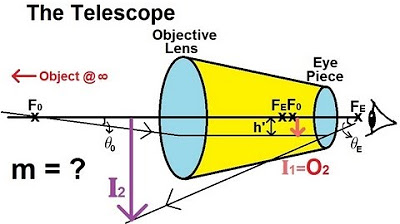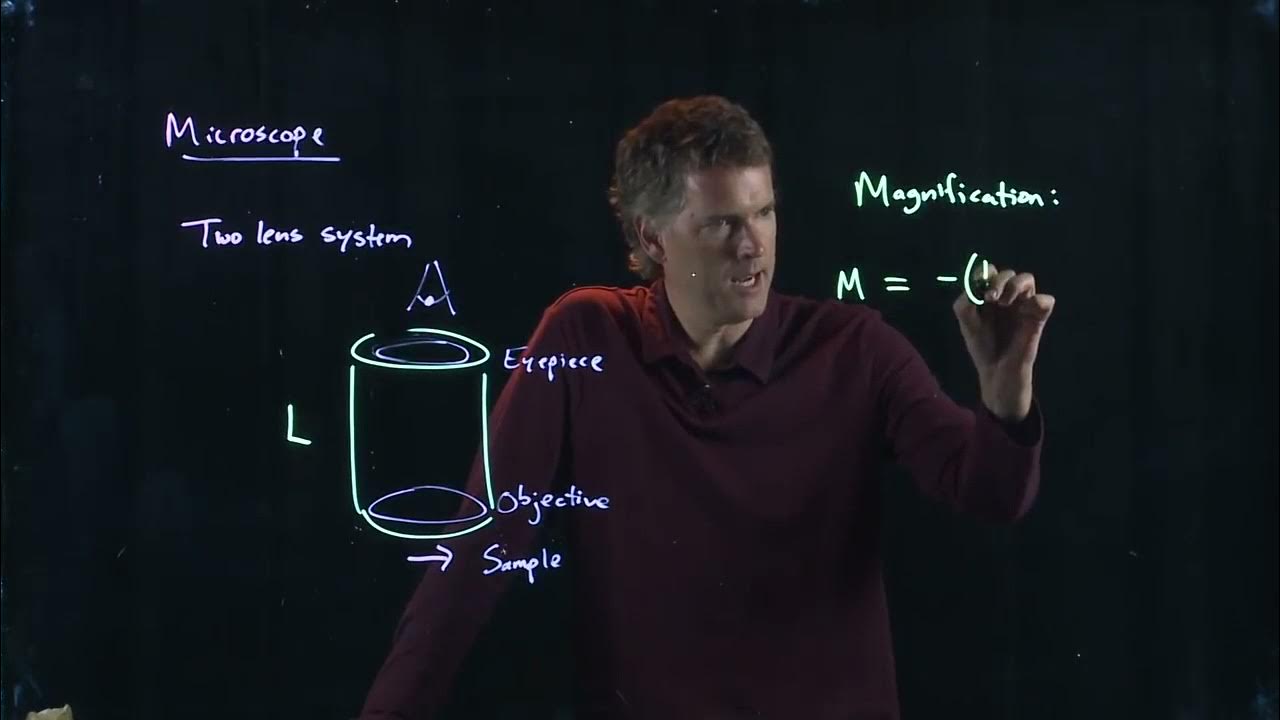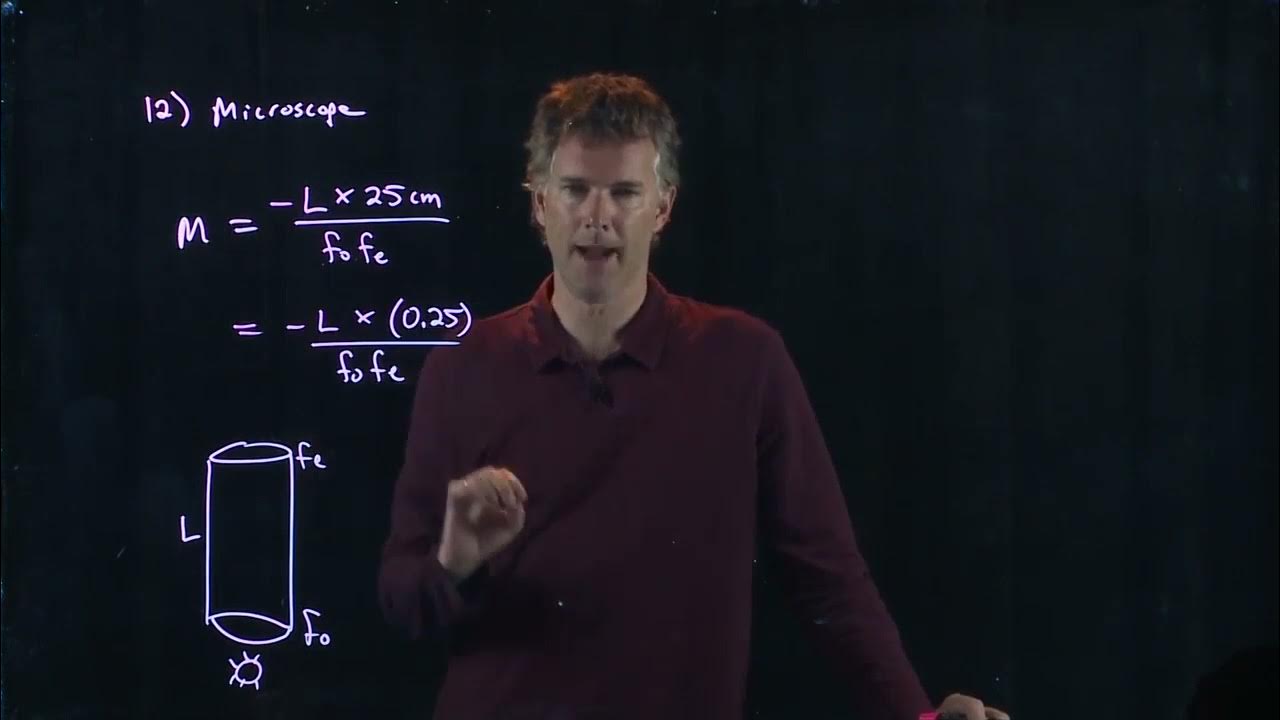The Telescope | Physics with Professor Matt Anderson | M28-13
TLDRThis script delves into the workings of a telescope, starting with a single lens and its focal length. It explains how a telescope, composed of an objective and an eyepiece, magnifies distant objects by using nearly parallel light rays. The key to a telescope's magnification lies in the ratio of the objective's long focal length to the eyepiece's short focal length. The script contrasts this with a microscope, which also aims to enlarge objects but is designed for close-up viewing. The explanation aims to clarify the principles behind these optical instruments and their respective applications.
Takeaways
- 🔭 Understanding Telescopes: The script begins with a discussion on single lenses, setting the stage for understanding the more complex design of telescopes.
- 👀 Single Lens Focus: The script explains the concept of focal length and how it relates to the positioning of an object and the formation of its image through a single lens.
- 🌟 Light Rays and Image Formation: It describes how parallel light rays interact with a lens, with some passing through the focal point and others bending towards it to form an image.
- 📐 Two-Lens System: The script introduces the two-lens system of a telescope, consisting of an objective lens and an eyepiece, used to magnify distant objects.
- 🌌 Distant Object Magnification: The script explains that telescopes are designed to magnify distant objects by using the nearly parallel light rays coming from them.
- 🔎 Objective and Eyepiece: The objective lens of a telescope is responsible for forming an intermediate image, which is then magnified by the eyepiece for the viewer.
- 🔄 Magnification Formula: The script provides a formula for the angular magnification of a telescope, which is the ratio of the objective's focal length to the eyepiece's focal length.
- ⏏️ Negative Sign in Magnification: It clarifies that the negative sign in the magnification formula indicates that the image is inverted, which is a common characteristic of telescopes.
- 🔬 Design Considerations: The script points out that for a high magnification in telescopes, one should have a long focal length for the objective and a short focal length for the eyepiece.
- 🌠 Telescope vs Microscope: It contrasts the design of telescopes with microscopes, noting that telescopes are for viewing distant objects while microscopes are for close-up observation.
- ❓ Open for Questions: The script concludes by inviting questions from the audience, indicating an interactive and informative approach to the subject matter.
Q & A
What is the basic concept of a single lens in optics?
-A single lens in optics is used to focus or disperse light rays. It can form an image of an object by bending the light rays to converge or diverge at a specific point known as the focal point.
What is the focal length of a lens?
-The focal length of a lens is the distance from the lens to the point where light rays parallel to the optical axis converge or appear to diverge when traced backward.
Why does the color change in the script when discussing the lens?
-The color change in the script is likely a visual aid to help distinguish different parts of the explanation or to highlight a specific aspect of the lens being discussed.
What is the purpose of an objective lens in a telescope?
-The objective lens in a telescope is used to collect light from a distant object and form an image of that object. It is typically the larger, front lens of the telescope.
What is the role of the eyepiece in a telescope?
-The eyepiece in a telescope is used to magnify the image formed by the objective lens, making the distant object appear larger and more detailed to the viewer.
Why are the light rays from a distant object nearly parallel?
-Light rays from a distant object are nearly parallel because the object is so far away that the angle at which the light enters the lens is very small, making the rays appear almost parallel.
What is the formula for the angular magnification of a telescope?
-The formula for the angular magnification of a telescope is given by m = -fo/fe, where fo is the focal length of the objective lens and fe is the focal length of the eyepiece.
Why is there a negative sign in the formula for angular magnification?
-The negative sign in the formula for angular magnification indicates that the image formed by the telescope is inverted. It does not affect the magnitude of the magnification.
How does the design of a telescope differ from that of a microscope?
-A telescope is designed to observe distant objects and requires a long focal length objective lens and a short focal length eyepiece. In contrast, a microscope is designed to observe close objects and uses a short focal length for both the objective and eyepiece.
What is the significance of the focal lengths in determining the magnification of a telescope?
-The magnification of a telescope is determined by the ratio of the objective lens's focal length to the eyepiece's focal length. A larger focal length for the objective and a smaller focal length for the eyepiece result in greater magnification.
How does the shape of the lenses in a telescope affect the image formed?
-The shape of the lenses in a telescope affects the image formed by determining how much the light rays are bent. A lens with a longer focal length is flatter and bends the light rays less, while a lens with a shorter focal length is more curved and bends the light rays more, affecting the size and clarity of the image.
Outlines
🔭 Understanding Telescopes with Lenses
This paragraph explains the basic concept of a telescope, which consists of an objective and an eyepiece. It starts by discussing the single lens and its focal length, then introduces the idea of using two lenses to form an image of a distant object. The explanation includes how the light rays from a distant object are nearly parallel and how they are focused by the objective lens to form an image. The eyepiece then magnifies this image, making it appear larger to the viewer. The paragraph also discusses the magnification formula for a telescope, which is the negative ratio of the objective focal length to the eyepiece focal length, and explains the significance of having a long focal length for the objective and a short focal length for the eyepiece to achieve high magnification.
🌟 Telescope vs Microscope: Magnifying Distant and Close Objects
The second paragraph focuses on the practical application of telescopes and microscopes, emphasizing their role in magnifying objects. It clarifies that the choice between a telescope and a microscope depends on the distance of the object from the viewer. If the object is far away, a telescope is required, while for close objects, a microscope is more appropriate. The paragraph also invites questions from the audience to ensure understanding and to address any doubts about the concepts discussed so far.
Mindmap
Keywords
💡Telescope
💡Single Lens
💡Focal Length
💡Objective
💡Eyepiece
💡Magnification
💡Angular Magnification
💡Parallel Rays
💡Microscope
💡Upside Down
Highlights
Understanding telescopes begins with a single lens discussion.
A single lens has a focal length where parallel rays focus.
The position of the image is determined by tracing rays back through the lens.
A telescope consists of two lenses: an objective and an eyepiece.
Distant objects emit nearly parallel light rays, forming an image at the focal point of the objective lens.
The eyepiece lens is used to magnify the image formed by the objective lens.
The magnification of a telescope is calculated by the ratio of the objective's focal length to the eyepiece's focal length.
A negative sign in the magnification formula indicates the image is inverted.
For high magnification in a telescope, a long focal length objective and a short focal length eyepiece are desired.
The objective lens of a telescope is typically far from the eye and has a long focal length.
The eyepiece lens is close to the eye, has a short focal length, and resembles the eyepiece of a microscope.
The design of a telescope is different from a microscope, with a long objective for distant viewing and short objectives for close viewing.
The purpose of both telescopes and microscopes is to magnify small objects, but their applications differ based on the distance of the objects.
Telescopes are used for observing distant objects, while microscopes are for close-up viewing.
The design principles of telescopes and microscopes involve manipulating focal lengths to achieve desired magnification.
The angular magnification formula, theta prime over theta, is used to compare the magnification with and without a telescope.
The magnification formula for a telescope is the negative objective focal length over the eyepiece focal length.
The transcript discusses the importance of lens curvature and focal length in telescope design.
Transcripts
Browse More Related Video

Physics 59 Optical Instruments (2 of 20) The Telescope

The Microscope | Physics with Professor Matt Anderson | M28-12

How telescopes work | Class12 (India) | Physics | Khan Academy

Focal Length of Eyepiece in a Microscope | Physics with Professor Matt Anderson | M28-22

Physics 59 Optical Instruments (3 of 20) The Microscope

Geometric Optics: Crash Course Physics #38
5.0 / 5 (0 votes)
Thanks for rating: